二语习得对英语教学的影响论文
- 格式:docx
- 大小:38.82 KB
- 文档页数:2
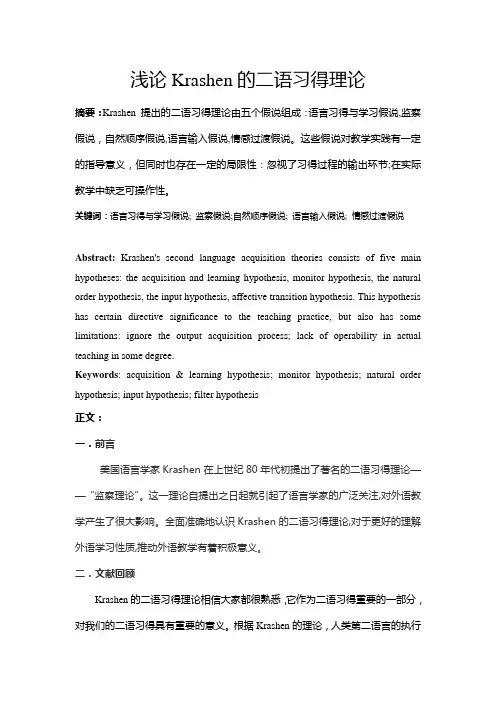
浅论Krashen的二语习得理论摘要:Krashen 提出的二语习得理论由五个假说组成:语言习得与学习假说,监察假说,自然顺序假说,语言输入假说,情感过渡假说。
这些假说对教学实践有一定的指导意义,但同时也存在一定的局限性:忽视了习得过程的输出环节;在实际教学中缺乏可操作性。
关键词:语言习得与学习假说; 监察假说;自然顺序假说; 语言输入假说; 情感过渡假说Abstract:Krashen's second language acquisition theories consists of five main hypotheses: the acquisition and learning hypothesis, monitor hypothesis, the natural order hypothesis, the input hypothesis, affective transition hypothesis. This hypothesis has certain directive significance to the teaching practice, but also has some limitations: ignore the output acquisition process; lack of operability in actual teaching in some degree.Keywords: acquisition & learning hypothesis;monitor hypothesis;natural order hypothesis;input hypothesis;filter hypothesis正文:一.前言美国语言学家Krashen在上世纪80年代初提出了著名的二语习得理论——“监察理论”。
这一理论自提出之日起就引起了语言学家的广泛关注,对外语教学产生了很大影响。

二语习得对英语教学的影响英语教学一直以来都是教育体系中的重点内容,同时也为教师增加了更多的难度,因为学生对外来语言的学习往往会产生一定的排斥感和畏难心理,这也会使教师失去教学的积极性和不断创新性,这样就会使英语教学发展停滞不前,但是,通过引入二语习得理论就会对英语教学的现状有所改进,能够进一步提高英语教学的质量和水平。
本文首先介绍了二语习得理论的基本内容,然后在此基础上,分析了二语习得对英语教学的重要影响,能够体现出二语习得促进了英语教学的快速发展,使学生能够更好更快地掌握第二语言的学习。
二语习得;英语教学;重要性随着现代教育行业的不断发展,在教学体系和模式中逐渐突出了学生的主体地位,学生不再只是被动地接受知识,而是积极主动地学习相关的知识,尤其对于英语语言的教学,传统的方式使英语教学不仅仅是教师需要面对的难题,同时学生因为学习困难也不愿意学习外语,所以,二语习得理论的引入十分重要,不仅仅进一步突出了学生的主体地位,同时也将教学重点逐渐转化为对学生综合能力的培养上,而不是纠结于某些语言上的错误,这对于教师来说,更容易引导学生进入学习状态,同时也能够使学生自由主动地研究英语语言的基本内容和在实际中的应用,使英语教学不再成为难题,而是教师和学生都比较感兴趣的语言学习过程,促进英语教学能够快速地发展。
一、二语习得理论介绍二语习得理论的基本内容。
二语习得理论结合了多方面的研究方法与研究格局,形成了不同的基本理论构成了二语习得理论,其中主要包括普遍语法论、监控理论以及环境论等三个构成部分。
首先,科学的研究已经证明,通过遗传基因能够赋予人类最普遍的语言知识,这种先天性的语言就叫作普遍语法,科学家认为,如果没有该天赋,那么无论是母语还是二语都无法习得,因为在语言的习得过程中,形成的语言数据在输入的过程中并不充分,不能够达到习得的程度,所以,普遍语法论能够广泛适用于语言的习得过程中,也是最基本的理论;对于监控理论主要包括了情感过滤假说、语言输入假说、监控假说、自然顺序假说以及语言习得与学习假说这5种假说。
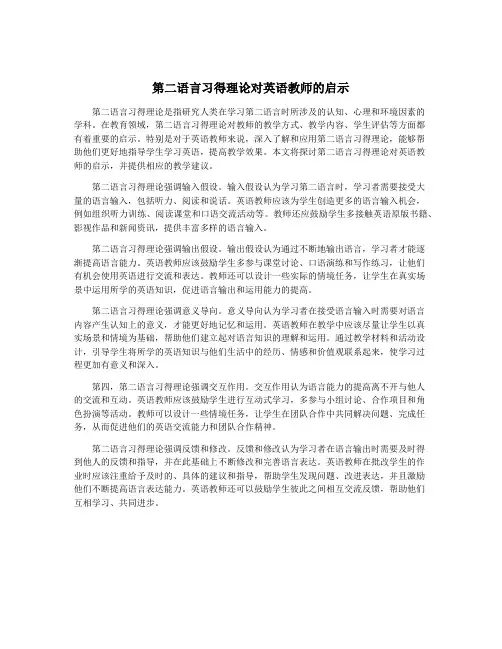
第二语言习得理论对英语教师的启示第二语言习得理论是指研究人类在学习第二语言时所涉及的认知、心理和环境因素的学科。
在教育领域,第二语言习得理论对教师的教学方式、教学内容、学生评估等方面都有着重要的启示。
特别是对于英语教师来说,深入了解和应用第二语言习得理论,能够帮助他们更好地指导学生学习英语,提高教学效果。
本文将探讨第二语言习得理论对英语教师的启示,并提供相应的教学建议。
第二语言习得理论强调输入假设。
输入假设认为学习第二语言时,学习者需要接受大量的语言输入,包括听力、阅读和说话。
英语教师应该为学生创造更多的语言输入机会,例如组织听力训练、阅读课堂和口语交流活动等。
教师还应鼓励学生多接触英语原版书籍、影视作品和新闻资讯,提供丰富多样的语言输入。
第二语言习得理论强调输出假设。
输出假设认为通过不断地输出语言,学习者才能逐渐提高语言能力。
英语教师应该鼓励学生多参与课堂讨论、口语演练和写作练习,让他们有机会使用英语进行交流和表达。
教师还可以设计一些实际的情境任务,让学生在真实场景中运用所学的英语知识,促进语言输出和运用能力的提高。
第二语言习得理论强调意义导向。
意义导向认为学习者在接受语言输入时需要对语言内容产生认知上的意义,才能更好地记忆和运用。
英语教师在教学中应该尽量让学生以真实场景和情境为基础,帮助他们建立起对语言知识的理解和运用。
通过教学材料和活动设计,引导学生将所学的英语知识与他们生活中的经历、情感和价值观联系起来,使学习过程更加有意义和深入。
第四,第二语言习得理论强调交互作用。
交互作用认为语言能力的提高离不开与他人的交流和互动。
英语教师应该鼓励学生进行互动式学习,多参与小组讨论、合作项目和角色扮演等活动。
教师可以设计一些情境任务,让学生在团队合作中共同解决问题、完成任务,从而促进他们的英语交流能力和团队合作精神。
第二语言习得理论强调反馈和修改。
反馈和修改认为学习者在语言输出时需要及时得到他人的反馈和指导,并在此基础上不断修改和完善语言表达。
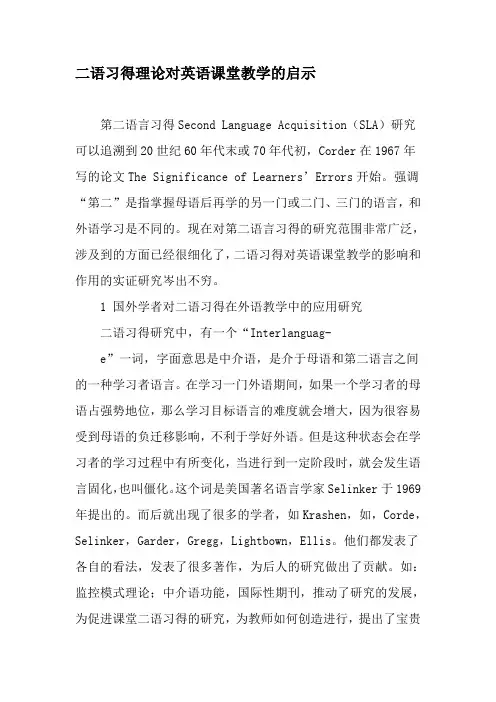
二语习得理论对英语课堂教学的启示第二语言习得Second Language Acquisition(SLA)研究可以追溯到20世纪60年代末或70年代初,Corder在1967年写的论文The Significance of Learners’Errors开始。
强调“第二”是指掌握母语后再学的另一门或二门、三门的语言,和外语学习是不同的。
现在对第二语言习得的研究范围非常广泛,涉及到的方面已经很细化了,二语习得对英语课堂教学的影响和作用的实证研究岑出不穷。
1 国外学者对二语习得在外语教学中的应用研究二语习得研究中,有一个“Interlanguag-e”一词,字面意思是中介语,是介于母语和第二语言之间的一种学习者语言。
在学习一门外语期间,如果一个学习者的母语占强势地位,那么学习目标语言的难度就会增大,因为很容易受到母语的负迁移影响,不利于学好外语。
但是这种状态会在学习者的学习过程中有所变化,当进行到一定阶段时,就会发生语言固化,也叫僵化。
这个词是美国著名语言学家Selinker于1969年提出的。
而后就出现了很多的学者,如Krashen,如,Corde,Selinker,Garder,Gregg,Lightbown,Ellis。
他们都发表了各自的看法,发表了很多著作,为后人的研究做出了贡献。
如:监控模式理论;中介语功能,国际性期刊,推动了研究的发展,为促进课堂二语习得的研究,为教师如何创造进行,提出了宝贵的意见。
2 国内学者对二语习得在外语教学中的应用研究二语习得的研究也得到了国内学者的关注,关于二语习得与课堂教学的研究有很多,中国外语教学发展过程中,国内学者主要是从社会语言学与心理语言学研究第一语言的习得规律来指导第二语言学习但如何将一语和二语理论与实践与课堂教学联系起来,还没有完全解决。
谈到课堂教学对二语的影响的研究主要从课堂教学对学习者总体语言能力的影响;课堂教学对语言输出准确度的影响;课堂教学对二语习得顺序的影响进行。
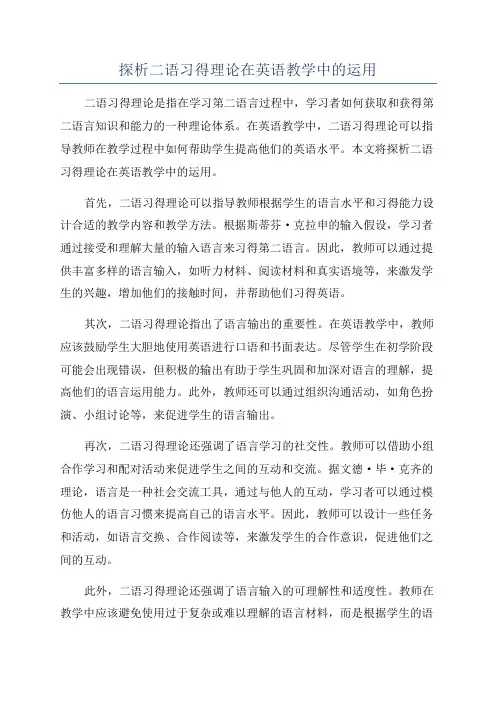
探析二语习得理论在英语教学中的运用二语习得理论是指在学习第二语言过程中,学习者如何获取和获得第二语言知识和能力的一种理论体系。
在英语教学中,二语习得理论可以指导教师在教学过程中如何帮助学生提高他们的英语水平。
本文将探析二语习得理论在英语教学中的运用。
首先,二语习得理论可以指导教师根据学生的语言水平和习得能力设计合适的教学内容和教学方法。
根据斯蒂芬·克拉申的输入假设,学习者通过接受和理解大量的输入语言来习得第二语言。
因此,教师可以通过提供丰富多样的语言输入,如听力材料、阅读材料和真实语境等,来激发学生的兴趣,增加他们的接触时间,并帮助他们习得英语。
其次,二语习得理论指出了语言输出的重要性。
在英语教学中,教师应该鼓励学生大胆地使用英语进行口语和书面表达。
尽管学生在初学阶段可能会出现错误,但积极的输出有助于学生巩固和加深对语言的理解,提高他们的语言运用能力。
此外,教师还可以通过组织沟通活动,如角色扮演、小组讨论等,来促进学生的语言输出。
再次,二语习得理论还强调了语言学习的社交性。
教师可以借助小组合作学习和配对活动来促进学生之间的互动和交流。
据文德·毕·克齐的理论,语言是一种社会交流工具,通过与他人的互动,学习者可以通过模仿他人的语言习惯来提高自己的语言水平。
因此,教师可以设计一些任务和活动,如语言交换、合作阅读等,来激发学生的合作意识,促进他们之间的互动。
此外,二语习得理论还强调了语言输入的可理解性和适度性。
教师在教学中应该避免使用过于复杂或难以理解的语言材料,而是根据学生的语言水平和学习需求选择合适的材料。
同时,教师还可以通过提供适当的文化背景知识和语言学习策略来帮助学生更好地理解英语,提高他们的语言运用能力。
最后,二语习得理论还提出了错误处理的重要性。
学习者在第二语言习得过程中不可避免地会出现错误,教师应该正确处理这些错误,帮助学生纠正和改进。
教师可以通过及时反馈、错误纠正和语言意识提高的活动来帮助学生修正错误,培养他们的语言敏感性和自我纠正能力。
![[“二语习得”研究对小学英语教学的启示]](https://uimg.taocdn.com/d98fc163aeaad1f346933fec.webp)
[“二语习得”研究对小学英语教学的启示] 摘要:在二语习得的理论体系中,以克拉申的“五个假说”影响力最大。
本文从他的二语习得理论,尤其是其中的“输入假说”和“情感过滤假说”出发,探讨了该理论对新课程标准下的小学英语教学的指导意义和借鉴作用。
关键词:习得学得输入假说情感过滤假说小学英语教学引言根据国家 __规定,我国小学已于xx年秋季开始从小学三年级起开设英语课。
这一重大举措引起了外语教学界的关注以及对诸多问题的探讨,如大纲的制定、教材的编写、师资的培训、教学模式及测试体系的建立等。
很多学者和专家已经意识到了中国英语教学本土化的问题,认为不能将西方的二语习得的研究成果照搬到我国的英语教学中。
但我认为学习语言的根本目的是运用语言,因此,小学英语教学的根本任务是培养学生运用英语的能力。
虽然二语习得的理论与我国的实际情况有差异,但对于我国的小学英语教学还是有一定的参考和借鉴价值的。
一、第二语言习得理论1957年,乔姆斯基提出了“语言习得机制”论(language Acquisition Device),它解释了儿童在语言习得过程中儿童有主动性和创造性的特点和儿童即使在恶劣的语言环境中也能最终习得母语的现象。
80年代初,受“语言习得机制”论的影响,克拉申(Krashen)建立了第二语言习得理论。
该理论以五个假说为基础:1.习得、学得假说(the Acquisition/ learning Hypothesis);2.自然顺序假说(the Natural Order Hypothesis):3.监视假说(The Monitor Hypothesis);4.输入假说(the Input Hypothesis);5.情感过滤假说(the Affective Filter Hypothesis)。
其中习得、学得假说为理论的基石,其核心思想是:人类学习第二语言依靠习得和学得两个途径。
习得(language acquisition)是指通过交际无意识地接触语言系统而掌握语言;学得(language teaming)指的人在习得母语后有意识地,通常是在教学环境里学习第二种语言知识的过程。
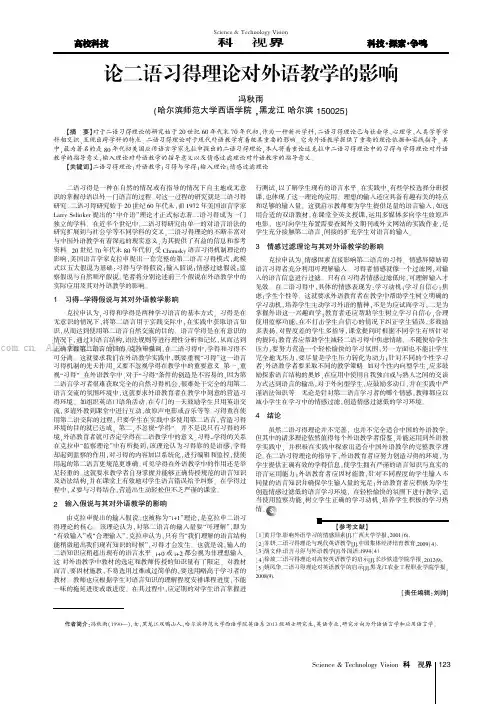
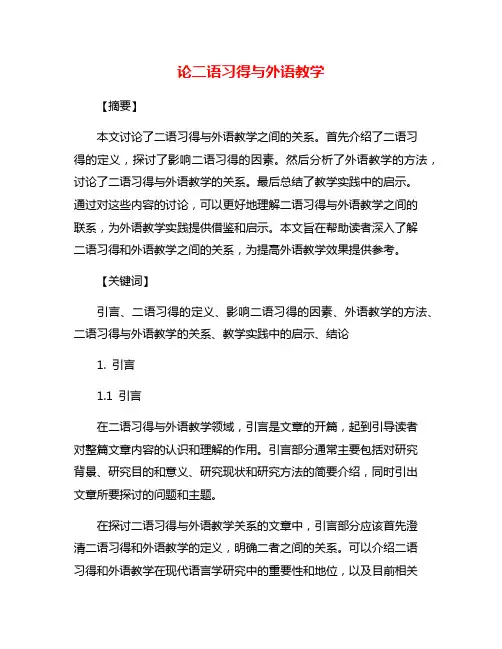
论二语习得与外语教学【摘要】本文讨论了二语习得与外语教学之间的关系。
首先介绍了二语习得的定义,探讨了影响二语习得的因素。
然后分析了外语教学的方法,讨论了二语习得与外语教学的关系。
最后总结了教学实践中的启示。
通过对这些内容的讨论,可以更好地理解二语习得与外语教学之间的联系,为外语教学实践提供借鉴和启示。
本文旨在帮助读者深入了解二语习得和外语教学之间的关系,为提高外语教学效果提供参考。
【关键词】引言、二语习得的定义、影响二语习得的因素、外语教学的方法、二语习得与外语教学的关系、教学实践中的启示、结论1. 引言1.1 引言在二语习得与外语教学领域,引言是文章的开篇,起到引导读者对整篇文章内容的认识和理解的作用。
引言部分通常主要包括对研究背景、研究目的和意义、研究现状和研究方法的简要介绍,同时引出文章所要探讨的问题和主题。
在探讨二语习得与外语教学关系的文章中,引言部分应该首先澄清二语习得和外语教学的定义,明确二者之间的关系。
可以介绍二语习得和外语教学在现代语言学研究中的重要性和地位,以及目前相关研究的热点和趋势。
引言部分还可以简要介绍本文的研究目的、意义和研究方法,为后续的正文部分打下基础。
通过引言部分的设计,读者可以更好地了解文章要讨论的问题和内容,对研究的背景和意义有一个清晰的认识,从而更好地理解和阅读后续的内容。
引言在整篇文章中的作用十分重要,可以帮助读者建立对文章结构和内容的整体把握,引导他们关注重点,更好地理解和掌握文章的内容。
2. 正文2.1 二语习得的定义二语习得是指在母语之外学习的第二种语言。
在语言学领域,二语习得被定义为通过学习和使用语言来实现对第二语言的内在模式或语法结构的训练。
二语习得不同于母语习得,因为学习者已经拥有母语知识,并且通过母语知识的影响来学习第二语言。
二语习得的过程是一种动态的、逐步的、有机的过程,学习者在不断接触第二语言的过程中,逐渐建立起对这种语言的模式和结构的认识。
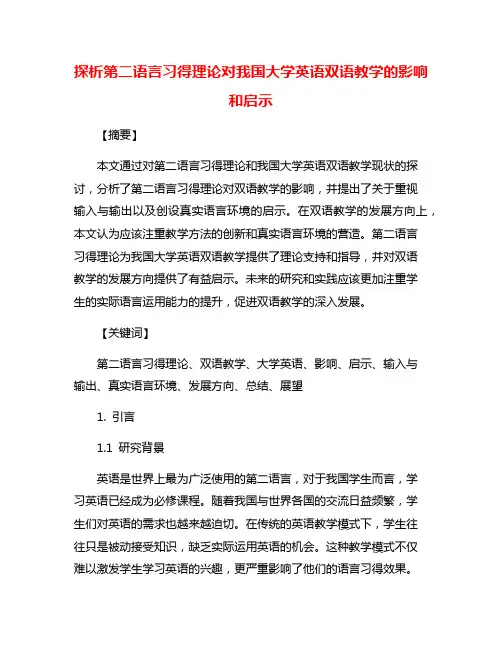
探析第二语言习得理论对我国大学英语双语教学的影响和启示【摘要】本文通过对第二语言习得理论和我国大学英语双语教学现状的探讨,分析了第二语言习得理论对双语教学的影响,并提出了关于重视输入与输出以及创设真实语言环境的启示。
在双语教学的发展方向上,本文认为应该注重教学方法的创新和真实语言环境的营造。
第二语言习得理论为我国大学英语双语教学提供了理论支持和指导,并对双语教学的发展方向提供了有益启示。
未来的研究和实践应该更加注重学生的实际语言运用能力的提升,促进双语教学的深入发展。
【关键词】第二语言习得理论、双语教学、大学英语、影响、启示、输入与输出、真实语言环境、发展方向、总结、展望1. 引言1.1 研究背景英语是世界上最为广泛使用的第二语言,对于我国学生而言,学习英语已经成为必修课程。
随着我国与世界各国的交流日益频繁,学生们对英语的需求也越来越迫切。
在传统的英语教学模式下,学生往往只是被动接受知识,缺乏实际运用英语的机会。
这种教学模式不仅难以激发学生学习英语的兴趣,更严重影响了他们的语言习得效果。
1.2 研究目的研究目的是探讨第二语言习得理论对我国大学英语双语教学的影响和启示,从而为双语教学的改进提供理论依据和实践指导。
具体目的包括:分析第二语言习得理论的核心概念和原理,以深入理解语言习得的本质及规律;调查我国大学英语双语教学的现状,了解存在的问题和挑战;探讨第二语言习得理论对双语教学的实际影响,从理论到实践的角度审视双语教学的有效性和改进空间;总结出重视输入与输出、创设真实语言环境等启示,为提升我国大学英语双语教学质量提供参考和建议。
通过本研究,旨在促进双语教学的发展,探索更符合语言习得规律的教学模式,为学生提供更优质的语言学习环境和更有效的学习方法。
2. 正文2.1 第二语言习得理论概述第二语言习得理论是指关于第二语言(或外语)学习和习得的理论体系。
最具代表性的是斯特拉维斯基的认知发展理论、克鲁斯的交流策略理论、斯蒂文斯的认知外语学习理论等。
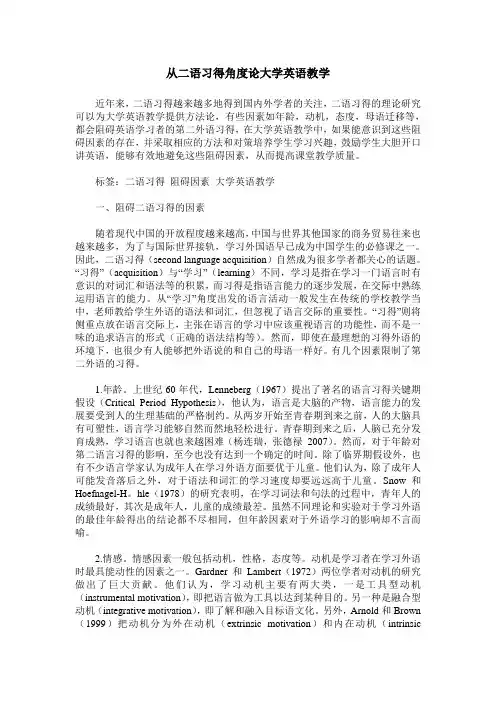
从二语习得角度论大学英语教学近年来,二语习得越来越多地得到国内外学者的关注,二语习得的理论研究可以为大学英语教学提供方法论,有些因素如年龄,动机,态度,母语迁移等,都会阻碍英语学习者的第二外语习得,在大学英语教学中,如果能意识到这些阻碍因素的存在,并采取相应的方法和对策培养学生学习兴趣,鼓励学生大胆开口讲英语,能够有效地避免这些阻碍因素,从而提高课堂教学质量。
标签:二语习得阻碍因素大学英语教学一、阻碍二语习得的因素随着现代中国的开放程度越来越高,中国与世界其他国家的商务贸易往来也越来越多,为了与国际世界接轨,学习外国语早已成为中国学生的必修课之一。
因此,二语习得(second language acquisition)自然成为很多学者都关心的话题。
“习得”(acquisition)与“学习”(learning)不同,学习是指在学习一门语言时有意识的对词汇和语法等的积累,而习得是指语言能力的逐步发展,在交际中熟练运用语言的能力。
从“学习”角度出发的语言活动一般发生在传统的学校教学当中,老师教给学生外语的语法和词汇,但忽视了语言交际的重要性。
“习得”则将侧重点放在语言交际上,主张在语言的学习中应该重视语言的功能性,而不是一味的追求语言的形式(正确的语法结构等)。
然而,即使在最理想的习得外语的环境下,也很少有人能够把外语说的和自己的母语一样好。
有几个因素限制了第二外语的习得。
1.年龄。
上世纪60年代,Lenneberg(1967)提出了著名的语言习得关键期假设(Critical Period Hypothesis),他认为,语言是大脑的产物,语言能力的发展要受到人的生理基础的严格制约。
从两岁开始至青春期到来之前,人的大脑具有可塑性,语言学习能够自然而然地轻松进行。
青春期到来之后,人脑已充分发育成熟,学习语言也就也来越困难(杨连瑞,张德禄2007)。
然而,对于年龄对第二语言习得的影响,至今也没有达到一个确定的时间。
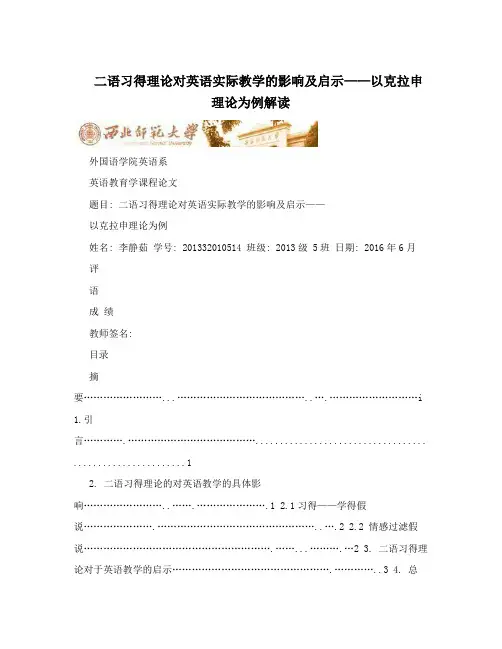
二语习得理论对英语实际教学的影响及启示——以克拉申理论为例解读外国语学院英语系英语教育学课程论文题目: 二语习得理论对英语实际教学的影响及启示——以克拉申理论为例姓名: 李静茹学号: 201332010514 班级: 2013级 5班日期: 2016年6月评语成绩教师签名:目录摘要 (i)1.引言....................................................................................... .. (1)2. 二语习得理论的对英语教学的具体影响……………………..…….………………….1 2.1习得——学得假说………………….…………………………………………..….2 2.2 情感过滤假说………………………………………………….……...……….…23. 二语习得理论对于英语教学的启示………………………………………….…………..34. 总结...............................................................................................3 参考书目.. (5)摘要本文从第二语言习得理论着手,分析了二语习得理论对于英语教学活动的影响及启示。
以著名语言教育家斯蒂芬?克拉申的两大假说理论,习得——学得假说和情感过滤假说为例,分析了理论对于教学活动的指导意义,包括其对于学生的学习方式形成的解释及学生学习过程中情感的作用,从而更好地指导教师进行教学活动。
关键字:二语习得;习得——学得假说;情感过滤假说;英语教i1. 引言第二语言习得,是指“在自然的或有指导的情况下通过有意识学习或无意识吸收掌握母语以外的一门语言的过程”。
只是作为第二语言是开始于幼儿期,包括按时间的第三次或以后的任何语言的学习。
二语习得研究是为了系统地探讨二语习得的本质和习得的过程,其主要目标是:描述学习者如何获得第二语言以及解释为什么学习者能够获得第二语言。
探析第二语言习得理论对我国大学英语双语教学的影响和启示随着全球化进程的加速和国际交流的日益频繁,作为国际通用语言之一的英语在我国的大学教育中变得越来越重要。
为了适应国际化的需要,我国许多大学已经开始实行双语教学,即在课堂教学中使用英语作为教学语言,以提高学生的英语水平和跨文化交际能力。
如何有效地开展双语教学成为了一个亟待解决的问题。
第二语言习得理论作为关于语言习得和教学的理论体系,对我国大学英语双语教学具有重要的影响和启示。
本文将从第二语言习得理论的角度探析其对我国大学英语双语教学的影响和启示。
第二语言习得理论为双语教学提供了理论支撑。
第二语言习得理论主张语言习得是一种自然而非计划性的过程,它强调了输入假设、交互作用假设等重要理论观点,指出了在正确的环境条件下,学习者会自然而然地习得目标语言。
针对这一理论观点,大学英语双语教学应该注重提供真实的语言输入和鼓励学生积极参与语言交际活动,从而创造一个良好的语言习得环境。
第二语言习得理论还强调了输出假设,即通过语言输出来促进语言习得。
在双语教学中,学生应该有更多的机会进行口语表达和书面表达,以巩固所习得的语言知识和技能。
第二语言习得理论为双语教学提供了理论支撑,为教师在实践中指明了方向。
第二语言习得理论为双语教学提供了教学策略和方法。
根据第二语言习得理论,很多研究者提出了一些有效的教学策略和方法,如任务型教学法、交际教学法、沉浸式教学法等。
这些教学策略和方法都强调了学生的主体地位,注重了学生的语言输出和交互。
在双语教学中,可以借鉴这些教学策略和方法,为学生提供更加自然和有效的语言习得环境。
可以设计一些有意义的任务来帮助学生运用所学的英语知识来解决实际的问题,或者组织一些角色扮演活动来促进学生的语言输出和交际。
通过采用这些教学策略和方法,可以更好地激发学生学习英语的兴趣和积极性,从而提高教学效果。
第二语言习得理论提醒我们关注学习者的个体差异。
第二语言习得理论认为每个学习者在语言习得过程中都有自己的个体特点和差异,这些差异包括认知差异、学习策略的差异、情感态度的差异等。
The Enlightenment of SLA Theory to Language Teaching1. The Enlightenment of SLA Theory to Language TeachingAs early as in the 1970 s many linguists and applied linguists had conducted extensive studies of second language acquisition (SLA). These linguists called the acquisition of the mother tongue first language acquisition and the acquisition of other languages beyond the mother tongue second language acquisition. The early SLA research was done for the purpose of improving language teaching, so people often classify these researches as the orientations of applied linguistics and foreign language teaching research. The researchers have been studying the cerebral surface features and the language acquisition mechanism of the second language since the 1980 s; therefore, SLA has grown rapidly as an independent subject.In the SLA field the researchers have offered various theoretic models to explain the process of second language acquisition. The most influential theory, also the best explained one, is the Monitor Model put forth by American linguist S.D. Krashen, who built this model on his five famous hypotheses, namely, input hypothesis, acquisition and learning hypothesis, monitor hypothesis, natural order hypothesis and affective filter hypothesis. These five hypotheses make unique and distinctive explanations of the process of second language acquisition. Input hypothesis, as the core of the Monitor Model, clearly tells us how language is acquired. As long as people understand the meaning of the words, they may acquire the language. This is the only way to learn language. Speaking and writing are of no help to language acquisition; only listening is.Krashensaid as long as learners come across words which contain“comprehensible input”, language acquisition happens. Progress in language learning is achieved when the“comprehensible input”is slightly higher than the learners present ability in understanding the language.Acquisition-learning hypothesis points out that“acquisition”and “learning”represent two distinct ways of language learning. In “acquisition” , an unconscious process of learning, such as children’s acquisition of their mother tongue, the meaning of words is usually understood in the course of communication and the use1山西师范大学学位论文of language is learned in an unconscious way,whereas“learning”is conscious and always acquires linguistic knowledge by means of learning the rules and forms of a language.If one acquires a language,they may not know the rules. However, if one learns a language,they must have a good command of rules.Langugae is at the center of human life. It is core of the most important ways of expressing ourselves. With the development of the society, it is not enough noly to be able to speak one’s own native language. In a world there are various languages. If you’d like to take part in the life of the whole world you need t know more languages. So language learning and teachig are vital to the everyday lives of millions.Being an english teacher, I do understand student’s trouble in learning a foreign language. Fifty-minute class sometimes seems to be an ordeal. The problem is that we do know “teaching” but do not know “learning”. That is an sqy we lack a theoy of language learining. So in the paper there are some concepts introduced such as learning and acquisition, foeign languae and second language and models of second language learning. I try to find out an appropriate way of teaching in my oral class. The aim of my class is to wake the entusiasm of the students’ study. So I try to do create a natural and relaxed calss atmosphere to make students learn foreign language through acquirig them.Only the linguistic knowledge through“acquisition”is helpful to the use of the language. The linguistic knowledge through learning, which is no help to the use of the language, can but monitor whether the words spoken are correct or not. As a result, the monitoring function of“learning”gives rise to the Monitor Hypothesis. The learners always gain language acquisition through“Comprehensible Input”which is higher than their present linguistic comprehension, so their process of acquisition must follow a certain predictable order to master the linguistic rules, thus producing“Natural Order Hypothesis”. The differences in the effect of language learning depends on learners and results from the psychological factors. The learners differences in motivation, attitude, confidence, etc., exert impact on the intake of“Comprehensible Input”and cause the differences in language acquisition.This is called the“Affective Filter Hypothesis”.2The Enlightenment of SLA Theory to Language TeachingAs we know, we master a language chiefly through two approaches: one is acquisition and the other is learning. We acquire as we are exposed to natural second language input that is comprehensible. It goes much the same way as a child acquires his first language—with no conscious attention to the language form. On the other hand, we learn in a conscious process of study and attention to form and rule learning. Krashen s Monitor Hypotheses holds the view that only acquired language is ready for natural and fluent communication. Native speakers rarely learn any rules but speak fluently while learnerswho focus on learning rules often fail to apply them in real nguage learning is suitable for linguistic monitor by way of using linguistic rules. Some people always check up the language they use with grammar so as to guarantee the correctness. This is called monitoring through learning. With continuing language progress, the use of the monitoring function becomes less and less frequent.Through the learning of a language,we find that a natural language environment is better than conscious learning and language acquisition is much more important than language learning.This is clearly seen in children s mother tongue acquisition.Conscious learning, while enabling learners to understand the structure and grammar of the language, may also inhibit language acquisition. This can be judged from examples of many adults failure to learn English. Krashen s theory gives us thehint that English should be acquired like children acquire their mother tongue. Then how can children succeed in using language? Although they are controlled to some extent in their language exposure, they are never consciously taught and they never learn consciously, either. But one thing we know is that they communicate a lot with adults (usually parents) in authentic, situational language. Their ability in using language comes from countless subconscious communications like this. Therefore, lots of language teaching experts attempt to teach English with the method with which children acquire mother tongue. In recent years, a lot of applied linguists with Ellis as the representative figure have paid more attention to language teaching. Expounding systematically the relationship between SLA studies and language teaching, they have proposed the input hypothesis, output hypothesis, intake hypothesis and internal3Interaction between Language Acquisition and Classroom Instructionsyllabus which are regarded as the theoretic bases that can revolutionize college English teaching.2. Interaction between Language Acquisition and Classroom InstructionTeaching practice without the guidance of theory is mostly blind and superficial. Learning, as a deep and reasonable scientific behavior, cannot do without the correct guidance of theory. Learning and teaching are closely interwoven, so are language acquisition and language teaching. Ellis calls it “an educational approach”to link language acquisition research closely with language teaching, it is clear that, such as the “interaction”between“language input”and SLA, the discrepancy between“naturalistic acquisition”and instructed learning, and so on.2.1 The Role of Classroom Instruction in Language Learning in SLAFirst of all, the classroom teaching conducted by teachers is closely linked with the two forms of SLA: the“natural acquisition”and“classroom learning”, which are interwoven and both exercise great influences on SLA. Although we cannot draw a clear distinction between“acquired language”and“instructed language”,we can easily understand the connotations of“language acquisition of classroom teac hing”and“language acquisition of non-classroom teaching”because the former is directly connected with classroom teaching. Ellis(1994) holds the view that the language acquisition through the second language teaching, whether by way of formal teaching or created conditions, will result in the increase of natural acquisition in classroom in an indirect way. Obviously, the influence of classroom teaching on language acquisition is positive. Secondly, as early as in 1984, the linguists represented by Long had conducted experiments on the influence of classroom teaching on the efficiency of language learning, the results of which support the viewpoint that classroom teaching benefits language acquisition.4山西师范大学学位论文2.2 The Theoretic Guidance of SLA Theory for Classroom TeachingAccording to my many years teaching practice, some theoretic models proposed in the SLA research field are really conducive to the improvement of classroom teaching quality, such as input hypothesis, output hypothesis and so on. Krashen (1982) proposes input hypothesis to explain the process of the birth of“acquisition”when learners receive language information input which are slightly deeper yet understandable. He takes the mentality that adults learning a second language will go through the same process of creative construction of language as children do acquiring their mother tongue. According to this hypothesis, the teacher should place students in the learning environment with the input and feedback of understandable information so as to let them“acquire”language. Furthermore, the teacher may apply this theory to the compilation of text-books and create diversified authentic language materials or establish a lively and realistic learning environment to augment comprehensible input so that learners may achieve better “acquisition”results.“Output”is a term relevant to input. The output theory proposed by Swain(1985)suggests that learners should use their acquired linguistic resources to practice producing the“comprehensible output” which is the output of their mind and to make“interactions”with“comprehensible output”.As we know, classroom interaction helps learners bridge the “input” and “output”.The language environment and learners internal mechanism, through classroom interaction, make learners acquire language in the course of “input”and“output”.Obviously, the information producer and information receiver together with the language environment are the key factors in both the classroom interaction and the improvement of classroom teaching quality. In other words, teachers produce information in which students are interested (information that leads to interaction) in classroom teaching and students collect, receive and reprocess the information so as to effectively acquire linguistic skills,5Interaction between Language Acquisition and Classroom Instructiongoing through the process of teacher—output of information—feed- back of information; students—receiving information—processing information—producing comprehensible output—acquiring language or skill. Teachers can use this theory to design their classes, adopt teaching activities with communication and task-based learning as the target and enable learners to practice producing“comprehensible output”to the maximum, thus making language acquisition happen.Ellis(1994)proposes the intake hypothesis that learners can momentarily “intake”in their brain a part of the input information, which will eventually be absorbed and become part of the information in the long-term memory. Teachers can improve their teaching if they know what information students are sensitive to and can easily“absorb”and how learners process and quicken the input they have received. In classroom teaching, teachers may select teaching materials, design class activities, and offer different teaching methods to learners according to this theory.SLA researchers hold that learners cannot expect the results overnight for language learning, which has different phases in its development, namely, the“internal syllabus”within learners. The“internal syllabus”theory holds that the phases in learning still receive the brain s phasic restraints on language acquisition in addition to learners own efforts. For example, when learners are learning the English present tense, they might progressively make the following sentences with the verb“read”:“Read the book”—I read the book.—She read the book.—She reads the book;Xiao Li read the book.—Xiao Li reads the book. ... This process, which shows learners internal acquisition schedule, is internal, natural and inevitable. Learners gain language acquisition through the“natural”development of“inter-language”and their own efforts. They may speed up the process, but cannot leap over it. Consequently, teachers should allow students to commit errors, finish their“internal acquisition schedule”and explain and correct these erro rs patiently. Mitchell&Myles observe, teachers found con-structions which were different in the two languages were not necessarily difficult, while constructions which were smiilar in them were notnecessarily easy, either. Further more, sometmies difficulty occurred in one direction but not in the other. Let me take Wh questions for example.In English we6Application of SLA in College English Teachingsay:What did you do yesterday? the corresponding Chinese order should be: you yesterday did what? In Englishwe put Wh at the beginningwhile in Chinese we just place itwhere it should be. In this sentence we should put Wh at the end. Contrastive Analysis would therefore predict that the placementofwhat would be difficult for both English learners of Chinese and Chinese learners ofEnglish. In fact, it isn t so. This kind of error never occurs on Chinese learners and at least they never put Wh wrongly. From the examplewe can see considering the great difference between Chinese and English syntaxes, there should have been more errors based on CA, but therewere not. Another example is I did nothing last nightbut to preparemy lessons. In this sentence, I wanted the students to tellme thewronguse of to , that is, we should omit it. However, they thought itwas rightand began to questionwhether itshould be prepare orprepare for Students had difficulty in whether a preposition should be used, but they did not commit an error in actual use. On the otherhand, theywere sure ofthe use to but in fact it was an error.3.Application of SLA in College English TeachingCollege English is a compulsory course for non-English major students at college or university set up by the Section of Higher Education of China s Ministry of Education. One of the important means to check college English teaching are the College English Tests band 4-6 (CET 4-6) conducted by the Ministry of Education since 1987. Yunnan, an undeveloped province in education, has adopted extra examinations of“YNTEC”and“YNCET-3”besides CET 4-6. For many years running because of insufficient educational funds, the shortage of qualified teachers, backward equipment and obsolete teaching methodology, the college English teaching in Yunnan province is faced with a lot of difficulties, seriously influencing the teaching quality. It is extremely urgent for teachers to apply the fruits of SLA research to the improvement of college English teaching.It s a well-known fact that the key to the improvement of teaching quality is to scientifically work out a teaching plan and select text-books, make definite the teachers function, responsibility and teaching attitude and select an appropriate7山西师范大学学位论文teaching methodology. The important role of SLA research is to help teachers determine these teaching decisions correctly. There exists a direct relationship between the property of language input, the learners learning process and the understanding of language acquisition patterns in the classroom and the guiding of the teaching plan because teachers understanding of language-teaching theory plays a significant and substantive role in the whole teaching process, concerning both important decisions such as syllabus design, text-book selection, and courses offered, and micro-techniques such as concrete classroom activities and homework. For example, the differences in choosing a teacher-centered or a learner-centered teaching mode will lead to differences in the choice of teaching plan, syllabus, text-book, teaching methodology and bring about different results and effects. Therefore, teachers who possess the knowledge of SLA theory will know how to avoid the wrong orientation in language teaching and how to lay down the teaching plan in accordance with the natural ways of language acquisition in teaching goals.The same case is found in the selection of text-book. According to SLA research, the content of courses should select authentic materials such as real communication recordings, TV clips, news broadcasts, signboards, pictures and schedules, instead of unfamiliar or politically-oriented language materials. If we review the teaching in the past, we will find out the reason why a college graduate or post-graduate student who has learned English for 15 or 16 years still fails to carry out daily English conversation or cope with the daily life using English. Besides providing teachers with the scientific guidance in their determination of role, responsibility and teaching attitude, SLA studies also help enable teachers to realize that they are not purely the source and tutor of professional knowledge and that they are not only the students controllers and learning evaluator but also the coach to students learning and the consultant, participant, cooperator and psychological supporter of the classroom activities. Teachers should accelerate learners learning process by encouraging them to adopt necessary learning strategies. SLA regards learning as a constructive building process and considers mistakes as an inevitable and positive part of the process. Therefore,teachers should have new awareness of8Effective Classroom Teaching Methodsstudents mistakes during their learning process, take new counter-measures and guidance and abandon some of the traditional inappropriate ways.Modern linguists take the view that teachers chief responsibility is to lay down plans, manage the interaction, monitor learning, explain the difficulties and offer timely feedback in learning. Therefore, teaching, I think, concerns the bilateral activities of both teachers teaching and students learning. As long as teachers know the function and responsibility in guiding learners learning, the learners will understand and participate in the design of courses and the selection of learning methods, take an active part in the design of language learning activities and shoulder the responsibility for their learning, thus effectively improving the teaching quality.Nowadays, it is very gratifying that through many linguists continuous research and practice and under the guidance of SLA theory, lots of scientific and effective teaching methods have been tried and found out, forming schools of teaching methodology. The representative teaching approaches now applied to classroom teaching include Direct Method, Audio-Lingual Method, Situational Methodand Communicative Approach.4.Effective Classroom Teaching MethodsThe Direct Method, an approach to design the English teaching process based on the psychological rocess of infants acquisition of their mother tongue, adopts visual aids and the teaching modes and methods which approximate real life and promotes teaching in a lively way. Like parents teaching their children to speak, the Direct Method requires teachers of English to directly teach English with material objects, pictures, gestures, facial expressions, actions, etc, and has achieved very good teaching results because of its rich language teaching environment.The Audio-Lingual Method, based on behaviorist theory, regards the process of language acquisition as a series of stimulus—reaction—copy—intensification. Viewing listening and speaking as the priority, the Audio-Lingual Method, can be seen as one part of the language acquisition process,and can effectively better reading and writing on the basis of listening and speaking. The Audio-Lingual Method9山西师范大学学位论文stresses the importance of students learning authentic phonetics and intonation, therefore requiring teaching material to exclusively use recordings of native speakers and classrooms to adopt a complete English environment by avoiding the use of the native tongue, so that learners will be able to use the correct language. It is obviously seen that the Audio-Lingual Method pays special attention to both the “quality” of the language input and the establishment of language environment.The Situational Method, also called the Audio-Visual Method, is a teaching approach developed on the basis of the Audio-Lingual Method. The Situational Method, besides stressing listening and speaking, also emphasizes“looking”, namely, the utilization of slide projector, projector, or teaching films during the teaching so as to provide students with pure and correct pronunciation and lively pictures as well. The students may look and speak while listening and they can also connect what they see with what they hear, so they are placed in an authentic language environment. It goes without saying that the teaching with the Situational Method tallies with the law of language acquisition, pays special attention to the“quality”of the language input, stresses the situational function of teaching and emphasizes the importance of language situation in language learning. The Direct Method and the Audio-Lingual Method both emphasize importance of natural acquisition of language and advocate teaching with the help of material objects. All the material objects are simple and concrete when applied in classroom teaching; therefore, the Situational Method, which pays more attention to the establishment of the real language environment, is very conducive to the promotion of learning and teaching, hence the better results.In the 1950 s the linguist Chomsky proposed the concept of linguistic competence. He held the view that once a person acquires language competence, he or she is then able to make innumerable sentences. Aiming at this theory, D. H. Hymes, an American social linguist, proposed the concept of“communicative competence”in the 1970 s. The Communicative Approach attaches importance to the cultivation of communicative competence, lays stress on students contact and use of rich authentic and natural language to form the ability to communicate in English and requires the arrangement of the authentic materials in a logical and reasonable situation in10Conclusionaccordance with social communication. The Communicative Approach stresses colloquial language practice and emphasizes the use of real and natural language, which resemble the process of natural language acquisition because spoken language holds the number one place and the process of communication always accompanies an authentic and natural situation.Obviously, the above-mentioned teaching methods value the imitation of the process of natural language acquisition and the creation of natural language environment in the course of teaching. If they can be authentically used in classroom instruction, then teaching quality can be greatly improved. What is worth noting is that the superiority of multi-media teaching technology has gradually emerged with the rapid development of computer technology. Auxiliary means of classroom teaching are not limited to slide shows, teaching films, videos and so on. Multi-media technology, convenient to operate, can access information at random, simulate and invent things, make up the deficiency of the Direct Method, the Audio-Lingual Method, the Situational Methodand the Communicative Approach in the creation of the language environment and offer richer images, A V, videos and words. Due to its combination of audio with vision and enhancement of the memory, Multi-media technology, which can achieve better teaching results, has become a comparatively ideal and effective teaching aid.5. ConclusionFrom the above mentioned, we can conclude that language teachers should strive to learn and master LA theory, ponder deeply over the relationship between SLA theory and language teaching, combine their own teaching practice, receive the scientific guidance of SLA theory, understand the orientation of language teaching in a correct way, make educational and teaching decisions, instill the new SLA theory into the teaching plan, the syllabus design, the selection of text-books and the choice of teaching methods, abandon the traditional old concept and practice which go against the law of language acquisition, re-determine the role, the position and the function of teachers in language teaching, establish teachers new image, responsibility,11山西师范大学学位论文and teaching attitude and choose the suitable teaching methods with multi-media teaching technology so as to greatly lift the efficiency of classroom language teaching and promote the steady growth of the college English teaching quality.12BibliographyBibliography[1]Brown, H. D. (2002).Principles of Language Learning and Teaching. ForeignLanguage Teaching and Research Press.[2]Cohen, A. D. (2000).Strategies in Learning and Using a Second Language.Foreign Language Teaching and Research Press.[3]Cook, V. (2000).Linguistics and Second Language Acquisition. Foreign LanguageTeaching and Research Press, Macmillan Publishers Ltd.[4]Dubin, F. & E. Olshtain. (2002).Courses Design. Shanghai Foreign LanguageEducation Publishing House.[5]Gardner, D. & L. Miller.(2002).Establishing Self Access from Theory to Practice.Shanghai Foreign Language Education Press.[6]Li, Jianfu. (2003). Interaction of background knowledge & common knowledge inforeign languages acquisition.Foreign Languages&Their Teaching,2.[7]Xiang, Maoying. (2003). Influences of affective factors on college Englishteaching.Foreign Languages&Their Teaching, 3.[8]Zhou, Ping & Zhang, Jisheng. (2003). On the interaction of SLA research &foreign languages teaching.Foreign Languages&Their Teaching, 2.13。
探析二语习得理论在英语教学中的运用【论文关键词】二语习得英语教学输入假说方法应用【论文摘要】二语习得理论经过发展现在已经成为了一门独立的学科,近年来其研究的领域不断扩大,尤其在英语教学方面的作用十分显著。
如何把英语教学工作做好是英语教学工作者最为关心的问题,本文就从二语习得理论的习得―学习假说、输入假说等五个方面出发,重点以输入假说为例进行介绍,通过论述它的主要原则、特点和存在的缺陷等几方面的问题,探讨其对英语教学的启示和在英语教学中的应用。
二语习得的研究兴起于20世纪70年代,发展至今,越来越受到学者的关注,对二语习得研究的主要目的就是为第二语言的教学提供一个合理的语言心理基础,因此,国内外二语习得研究者进行了大量的研究,这些研究对于我国大学英语教学方面具有重大的理论价值和启发意义。
下面本文就对二语习得的理论进行简单的论述。
一、二语习得理论简介(一)习得―学习假说第二语言的学习可以通过两种方式,语言习得和语言学习。
语言习得是学习者潜意识过程中的产物,是其在用目标语言进行交流,并且在交流的过程中不注重语言的形式,而只关注交流的内容。
语言学习则是学习者有意识学习的产物,以获得和语言相关的知识为目的。
[1]通过研究发现,这种潜意识的语言习得者在日常交流过程中不能流利的使用语言,而语言学习者则能够在实际中将语言运用自如。
(二)监控假说这一假说说明语言习得系统才是真正的语言能力,而语言学习系统要想发挥作用,必须具备三方面的因素,一是具有充足的时间进行有效的选择和运用;二是要具有一定的语言形式,使语言使用者具备运用语言的正确形式,使监控系统发挥作用;三是语言使用者必须要熟知使用语言的规则。
[2](三)情感过滤假说这一假说强调,语言的输入必须要通过情感的过滤,才能够被语言学习者所掌握,而这些情感因素包括了自信、焦急等情感。
[3]但是在语言习得的过程中,如果情感因素过于强烈,就会阻碍语言输入的进行,对语言的学习造成阻碍。
第二语言习得理论在英语教学中的应用随着全球化和国际化的发展,英语作为全世界使用最广泛的语言之一,在中国的教育、经济、文化等各个领域都扮演着重要的角色。
因此,英语学习已成为现代化教育的重要内容之一。
然而,对于普通学生来说,学好英语并非易事。
在这个过程中,第二语言习得理论成为了英语教学师生们的重要研究对象。
第二语言习得理论,其目的是帮助人们更好地学习和掌握第二语言(L2)。
而对于英语教学而言,第二语言习得理论更是可以为英语教育者提供更好的指导方法和灵感。
基于这种理念,本文旨在探讨第二语言习得理论在英语教学中的应用。
第一部分:第二语言习得理论第二语言习得理论是指人们在学习第二语言时的内在心理过程。
研究发现,人们习得第二语言存在着与习得母语不同的心理机制和规律。
具体来说,第二语言习得理论主要包括以下几个方面:1、语言输入语言输入是指人们学习语言的过程中所接受到的信息。
语言输入对于第二语言习得的作用是至关重要的。
语言输入质量的高低会对第二语言习得产生积极或消极的影响。
与母语习得不同,第二语言习得需要有大量的相关语言输入。
同时,这种语言输入需要针对语言学习者的语言水平和语言需求等问题进行定制和设计。
2、暴露度和密度暴露度和密度是指第二语言习得者与第二语言接触的频率和持续时间。
如果学习者的暴露度和密度越高,那么其第二语言习得的速度和效果也就越高。
3、语言输出语言输出是指说话和写作等语言表达方式。
语言输出对于第二语言习得也有很大的作用。
通过自由的语言输出,第二语言习得者可以更好地巩固学习的知识和技能,并且可以更好地理解和应用学习过程中的错误。
4、语言规则和语言结构的学习语言规则和语言结构的学习是指学习者在习得第二语言的时候所需要掌握的基本语言规则和语言结构,包括句子结构、语法、单词运用等等。
这是学习者在语言习得过程中必须重点学习的内容。
第二部分:第二语言习得理论在英语教学中的应用1、提供优质的教育资源提供优质的教育资源是英语教学的重要组成部分。
第二语言习得对中国英语教学的影响陈晓晶【摘要】:本文回顾了第二语言习得理论进入中国的历史过程,并着重阐述了它对中国英语教学的影响:1.二语理论使研究英语教学的角度发生了转换。
2.二语理论促进了研究英语教学方法的改进。
3.二语理论使英语教学界对英语教学的目的有了更清楚的认识。
4、二语理论促使中国英语教学真正落实了“以学习者为中心”的思想。
5.二语理论改变了英语教师对学生语言错误的看法。
【关键词】:第二语言习得理论外语教学1960年代开始,有人研究人们获得语言能力的机制,尤其是获得外语能力的机制,综合了语言学、神经语言学、语言教育学、社会学多种学科,慢慢发展出一门新的学科,叫“二语习得”,Second Language Acquisition。
语言是人类区别于其他动物的重要标志之一。
人借助于语言进行交际,交流思想,达到互相了解,组成人类社会生活;人还借助于语言,进行思维活动,揭露事物的本质和规律,创造人类的物质文明和精神文明,然而语言的作用还远不止如此。
如果我们探讨外语学习心理的主要目的是教好一门语言,是帮助学习者学会用这门外语进行交际,那么,我们应该懂得什么是语言。
第二语言习得理论作为一门独立的学科形成于60年代末,70年代初。
然而,人们对第二语言习得产生兴趣和开展研究的历史却要早得多。
50年代初,Weinreich就在它的著作《语言的联系》中讨论了母语和第二语言两种语言体系的关系,并提出了一个重要的概念“干扰”。
这种干扰可以发生在语音、语法、语义三个层面上。
1957年,美国语言学家Robert Lado发表了具有很大影响的著作《跨文化语言学》。
从某种意义上来说,Lado的著作是对Weinreich理论的补充。
Lado的结论是:“对第二语言学习者来说,学习中最为困难的地方就是第二语言与第一语言差别最大的地方。
因此,外语教学的重点应该集中在两种语言的差别上。
”将语言习得中的某些因素借鉴于外语学习,从而提高外语教学的效果,这是一个令人感兴趣的问题。
二语习得理论对大学英语教学的影响语言是人类文明的重要构成要素。
相对来说,语言分为母语和非母语两种形式,人类语言是通过自然母语的习得以及其他语言的学习获取的。
二语习得通常是指人类个体在母语习得之后对其他任何非母语语言的学习。
语言习得理论主要研究人们学习第二语言的过程和结果。
外语教学中,借助于二语习得理论来指导和优化教学过程,对提高教学质量意义深远。
本文以美国语言学家克拉申的二语习得理论为视点,针对二语习得理论对大学英语教学的影响进行了阐述和分析。
一、第二语言习得理论概述现代语言学认为,语言是对人们相互进行思维、情感或意念交流的声音行为的概括,它是人们用来传递人类文明成果的重要交际工具。
二语习得是在自然掌握了一定母语系统的情况下,在第二语言的特定社会环境中进行学习第二语言的过程。
二语习得是一个复杂的过程,受学习内容、教学方法、学习者的个性差异以及自身素质等诸多因素影响和制约。
二语习得理论,是在研究第二语言习得过程及其语言规律的基础上提出来的,其目的是客观的描述解释关于学习者的第二语言特征、语言能力和交际能力的发展变化规律,并分析影响二语习得的各种因素。
美国语言学家克拉申提出的第二语言习得理论,引起了语言学界普遍关注。
概括地说,二语习得研究是通过语言学、心理学、教育学、社会学等相关学科的研究,描述学习者获得第二语言的本质和过程。
其有关外语教学的理论精华如下:1语言输入理论:克拉申二语习得理论认为,语言输入是指学习者在语言环境中所接受的语言信息。
人类语言的掌握是通过无意识的习得或有意识的学习两种方式获得的。
克拉申认为,习得方式要比学习方式更重要。
可理解性语言是语言输入的关键。
2 语言输出理论语言输出是指学习者在熟练掌握一定的语言信息后,运用已经获得的语言信息技能进行练习,发出可理解性输出,已达到语言交际的目的。
语言输出受语言习得环境以及学习者自身的素质影响巨大。
3 情感过滤假设克拉申理论认为,第二语言习得的过程要受许多情感因素的影响。
二语习得对英语教学的影响论文
(摘要)英语教学一直以来都是教育体系中的重点内容,同时也为教师增加了更多的
难度,因为学生对外来语言的学习往往会产生一定的排斥感和畏难心理,这也会使教师失
去教学的积极性和不断创新性,这样就会使英语教学发展停滞不前,但是,通过引入二语
习得理论就会对英语教学的现状有所改进,能够进一步提高英语教学的质量和水平。
本文
首先介绍了二语习得理论的基本内容,然后在此基础上,分析了二语习得对英语教学的重
要影响,能够体现出二语习得促进了英语教学的快速发展,使学生能够更好更快地掌握第
二语言的学习。
(关键词)二语习得;英语教学;重要性
随着现代教育行业的不断发展,在教学体系和模式中逐渐突出了学生的主体地位,学
生不再只是被动地接受知识,而是积极主动地学习相关的知识,尤其对于英语语言的教学,传统的方式使英语教学不仅仅是教师需要面对的难题,同时学生因为学习困难也不愿意学
习外语,所以,二语习得理论的引入十分重要,不仅仅进一步突出了学生的主体地位,同
时也将教学重点逐渐转化为对学生综合能力的培养上,而不是纠结于某些语言上的错误,
这对于教师来说,更容易引导学生进入学习状态,同时也能够使学生自由主动地研究英语
语言的基本内容和在实际中的应用,使英语教学不再成为难题,而是教师和学生都比较感
兴趣的语言学习过程,促进英语教学能够快速地发展。
一、二语习得理论介绍
二语习得理论的基本内容。
二语习得理论结合了多方面的研究方法与研究格局,形成
了不同的基本理论构成了二语习得理论,其中主要包括普遍语法论、监控理论以及环境论
等三个构成部分。
首先,科学的研究已经证明,通过遗传基因能够赋予人类最普遍的语言
知识,这种先天性的语言就叫作普遍语法,科学家认为,如果没有该天赋,那么无论是母
语还是二语都无法习得,因为在语言的习得过程中,形成的语言数据在输入的过程中并不
充分,不能够达到习得的程度,所以,普遍语法论能够广泛适用于语言的习得过程中,也
是最基本的理论;对于监控理论主要包括了情感过滤假说、语言输入假说、监控假说、自
然顺序假说以及语言习得与学习假说这5种假说。
由于篇幅限制,这里只介绍一种假说为例,针对其中的语言习得与学习假说而言,克氏认为语言的习得主要需要经过习得和学得
两个过程,其中习得主要是指学习者借助与外界的广泛交际和实践,并没有意识到接收到
了该语言,同时能够在无意识下,正确地使用该语言,而学得主要是指有意识地进行研究,并且通过理性的方式理解这种语言,所以能够充分地看出,习得能够使学习者对语言的学
习更加充分和自由,表达方面也比较流利,而学得则会使语言的学习更加趋于刻板化和教
条化,是对语言有规则的监控,这就证明了习得的重要性,这就是语言习得与学习假说。
总之,二语习得主要取决于主体对于目标语的文化的趋同、接触、接受以及适应程度。
二、二语习得对英语教学的影响
1.二语习得转换了研究英语教学的角度。
二语习得主要研究目标是描述学者是怎样获
得的第二语言以及对为什么能够获得第二语言进行解释,主要强调地是以学习者作为主体,对学习者进行多角度和全方位地研究和分析,对学习者的个人差异以及内部与外部因素进
行深度地研究。
在现代英语教学中,也开始探寻以学生为主要服务对象的教学模式,但是
出现的研究理论主要围绕的是“如何教”,通过二语习得理论的引进,转换了英语教学的
视角,使研究逐渐从教法过渡到了学习者的身上,变成了如何学、学习者的认知以及情感
需要等相关研究,进一步创新了英语教学的模式和理念。
2.二语习得提高了对英语教学的
认识。
在传统的英语教学中,一直将语法分析等内容作为教学的主要目的.,后来开始添
加了对学生语音、语法、词汇等综合运用能力的培养,主要体现在听说读写四个方面,之
后又把培养学生的交际能力作为教学的主要目的。
英语教学的目的不断发生变化,通过二
语习得理论的逐渐引入,英语教学的最终目标开始重点培养学生对英语语言的综合运用能力,该能力的形成主要建立在学生文化意识、学习策略、语言技能、情感态度以及语言知
识等不同素养的综合发展的基础上,通过对这些素养的综合评价才能够形成对学生培养的
根本目标,这也是英语教学的主要目的。
3.二语习得改变了教师对学生所犯语言错误的看法。
许多英语教师坚决反对学生出现语言偏误,认为这是学习过程中的最大障碍,直到今天,英语教师也十分重视发音问题,并且经常以语音作为对语言习得程度的评判标准。
二
语习得理论的出现,尤其是进一步引导英语教学不应该过于重视学习者出现的错误,而应
该认识到这是语言学习中的正常现象,是学习者积极主动向语言进行靠拢的表现,不应该
将错误看作学习中的消极因素,而是需要不断鼓励学生更加努力的掌握英语知识和实际的
应用本领,转化为正能量来督促学生,更加有利于英语教学水平的提高。
三、结论
通过本文的研究能够发现,英语教学虽然相对比较困难,但是如果运用正确的方法,
使学生充分的吸收知识也是比较容易的事情,借助二语习得理论,英语教学从教学方法、
教学目标和教学视角等多个方面都发生了变化,使教师能够正确科学地引导学生学习英语
和应用英语,同时也能够促进学生对语言的充分掌握,并且在实际中能够运用自如,这样
才能够将英语语言的价值充分发挥和展现出来。
参考文献:
[1]何璐.探析二语习得中母语负迁移理论对英语教学的影响[J].科技信
息,2021,31:287+236.
感谢您的阅读,祝您生活愉快。